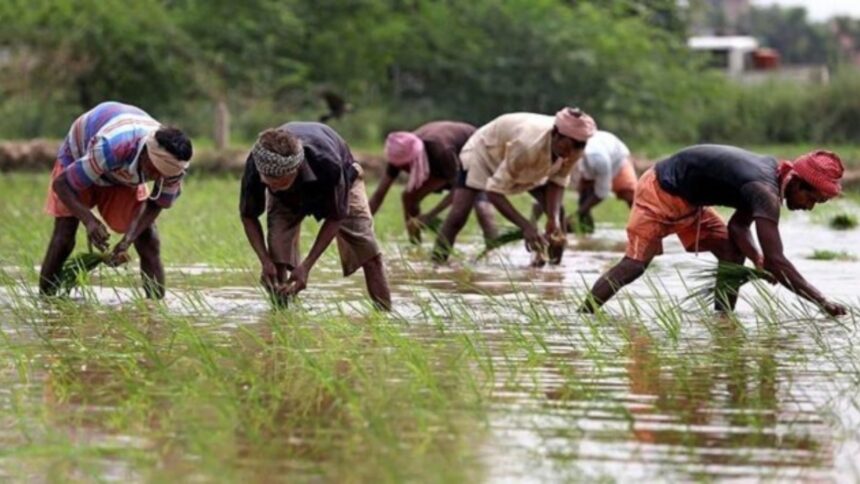Amid the uncertainties and disruptions resulting from the ongoing global tariff war, India’s growth prospects seem to be at risk. Concerns have been raised over the future trajectory of capital expenditure and private sector investment for India, as the impact of a slowing global economy will make its way to domestic shores, sooner or later. But, there is a silver tint in the clouds of doubt — a good projection for the monsoon that augurs well for agriculture.
Agriculture, which accounts for around 16 per cent share in the Gross Domestic Product (GDP) of the country and supports over 46 per cent of the population, has shown resilience over the last few years, especially in the post-Covid phase. The agricultural sector’s annual growth has remained consistently above 4 per cent (except 2.7 per cent in 2023-24) in the last five years starting from the pandemic year 2020-21. This year, too, it is expected to gain with an above-normal rainfall forecast for the four-month long monsoon season in India. The monsoon season is likely to bring rainfall at 105 per cent of the long-period average, the India Meteorological Department said in its forecast released Tuesday. This would mark the second consecutive year of ‘above normal’ rainfall for India and the country would receive 100 per cent or more rainfall this season for the fifth time in the last seven years since 2019.
Global risks, domestic support
An above-normal monsoon is expected to spur consumption demand, especially in rural areas. Coupled with lower and softer crude oil prices, it is seen supporting growth. Estimates of agricultural production also suggest a positive outlook for food inflation, as per the latest economic review of the Ministry of Finance. As per the second advance estimates, kharif and rabi food grain output is expected to rise by 6.8 per cent and 2.8 per cent, respectively. Among cereals, kharif rice production is projected to grow by 6.6 per cent, while wheat output is expected to reach a record 1,154.3 lakh tonnes.
However, headwinds from global trade disruptions continue to pose downward risks for India, as was noted by the Reserve Bank of India in its latest monetary policy review on April 9. The real GDP growth for 2025-26, as per the RBI, is projected at 6.5 per cent lower than earlier projection of 6.7 per cent, with Q1 growth seen at 6.5 per cent; Q2 at 6.7 per cent; Q3 at 6.6 per cent; and Q4 at 6.3 per cent.
Most forecasts by economists have slashed India’s growth projections for the ongoing financial year 2025-26 by at least 20 basis points. However, a likely pickup in rural demand with softening food inflation and crude prices have been underlined as the positive factors. “Apart from the direct impact of higher tariffs, there would be a severe indirect impact as global growth slows and capital flows to emerging economies are adversely impacted. India’s domestic investors will also get wary amid the ongoing global disruptions. Hence, the gradual growth of private sector investment post-Covid could remain tepid in the coming quarters. We expect India’s GDP growth to moderate to around 6.2 per cent in FY26 from our estimate of 6.4 per cent growth in FY25. The supporting factors for the economy would be the chance of a normal monsoon season and healthy agriculture production,” Rajani Sinha, chief economist, CareEdge Ratings said.
Rural demand pickup
Rural demand is showing some signs of revival with pick-up in FMCG sales volume growth, rise in fertiliser and tractor sales, Gaura Sen Gupta, chief economist, IDFC FIRST Bank said. “Meanwhile urban demand remains more subdued than rural demand. Softness in urban demand is indicated by passenger vehicle sales and electronic payments data,” she said.
The demand for work under the rural employment guarantee scheme — Mahatma Gandhi National Rural Employment Guarantee Scheme (MGNREGS) — at the national level remains above the pre-Covid levels even as it has steadily declined from its peak in 2020-21 during the pandemic. Compared with pre-Covid levels, the demand is still significantly higher, with 85 lakh more families availing of the rural job scheme in 2024-25 than in 2019-20.
The rising MGNREGA demand is not necessarily a sign of rural distress, whereas a falling MGNREGA demand is definitely a sign of dissipation of rural distress, Chief Economic Advisor V Anantha Nageswaran said during ’ Idea Exchange last week.
Softening inflation, rate cuts
While a normal monsoon and softening global commodity prices will support inflation, the impact of weather-related disturbances on food inflation will require monitoring. Inflationary concerns, especially for food inflation, have abated for the Indian economy, even as growth concerns have escalated. CPI inflation eased to a near-six year low of 3.34 per cent in March and is expected to remain below 4 per cent, the baseline target of the RBI’s 4+/- 2 per cent target, in the next few months. RBI has also cut its forecast for retail inflation for FY26 to 4 per cent from their previous estimate of 4.2 per cent.
The RBI, which cut the key policy rate by 25 basis points in its latest monetary policy review earlier this month, is expected to cut rates further by 50 basis points in FY26, with a likely deeper rate cut cycle in case of heightened growth risks from the global tariff war.
Going forward, as per the RBI, on the supply side, while agricultural prospects appear bright, industrial activity is recovering, and the services sector is expected to be resilient. Sustained demand from rural areas, an anticipated revival in urban consumption, expected recovery of fixed capital formation supported by increased government capital expenditure, higher capacity utilisation, and healthy balance sheets of corporates and banks are expected to support growth, it said.








